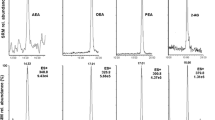Abstract
Endocannabinoids at nanomolar physiological concentrations cross cellular membranes by facilitated diffusion, a process that can be studied by measuring transport kinetics and endocannabinoid trafficking employing radioligands and mass spectrometry. Here, we describe radiosubstrate-based assays using arachidonoyl[1-3H]ethanolamine and 2-arachidonoyl[1,2,3-3H]glycerol to measure cellular endocannabinoid uptake in a three-phase assay with human U937 cells. Liquid chromatography–electrospray ionization–mass spectrometry (LC–ESI–MS/MS)-based lipidomics was used to interrogate the roles of serum and albumin for endocannabinoid trafficking in U937 cells.
Access this chapter
Tax calculation will be finalised at checkout
Purchases are for personal use only
Similar content being viewed by others
References
Nicolussi S, Gertsch JJ (2015) Endocannabinoid transport revisited. Vitam Horm 98:441–485
Fowler CJ, Tiger G, Ligresti A et al (2004) Selective inhibition of anandamide cellular uptake versus enzymatic hydrolysis—a difficult issue to handle. Eur J Pharmacol 492:1–11
Oddi S, Fezza F, Catanzaro G et al (2010) Pitfalls and solutions in assaying anandamide transport in cells. J Lipid Res 51:2435–2444
Nicolussi S, Chicca A, Rau M et al (2014) Correlating FAAH and anandamide cellular uptake inhibition using N-alkylcarbamate inhibitors: From ultrapotent to hyperpotent. Biochem Pharmacol 92:669–689
Fowler CJ (2013) Transport of endocannabinoids across the plasma membrane and within the cell. FEBS J 280:1895–1904
Felder CC, Dickason-chesterfield AK, Moore SA (2006) Cannabinoid Biology The Search for New Therapeutic Targets. Rev Lit Arts Am 6:149–161
Chicca A, Marazzi J, Nicolussi S et al (2012) Evidence for bidirectional endocannabinoid transport across cell membranes. J Biol Chem 287:34660–34682
Nicolussi S, Viveros-Paredes JM, Gachet MS et al (2014) Guineensine is a novel inhibitor of endocannabinoid uptake showing cannabimimetic behavioral effects in BALB/c mice. Pharmacol Res 80:52–65
Chicca A, Nicolussi S, Bartholomäus R et al (2017) Chemical probes to potently and selectively inhibit endocannabinoid cellular reuptake. Proc Natl Acad Sci U S A 114:E5006–E5015
Reynoso-Moreno I, Chicca A, Flores-Soto ME et al (2018) The endocannabinoid reuptake inhibitor WOBE437 is orally bioavailable and exerts indirect polypharmacological effects via different endocannabinoid receptors. Front Mol Neurosci 11:180
Reynoso-Moreno I, Tietz S, Vallini E et al (2021) Selective endocannabinoid reuptake inhibitor WOBE437 reduces disease progression in a mouse model of multiple sclerosis. ACS Pharmacol Transl Sci 4:765–779
Ahn K, McKinney M, Cravatt B (2008) Enzymatic pathways that regulate endocannabinoid signaling in the nervous system. Chem Rev 108:1687–1707
Gibellini F, Smith TK (2010) The Kennedy pathway--De novo synthesis of phosphatidylethanolamine and phosphatidylcholine. IUBMB Life 62:414–428
Madeira A, Moura TF, Soveral G (2015) Aquaglyceroporins: implications in adipose biology and obesity. Cell Mol Life Sci 72:759–771
Cravatt BFB, Giang DK, Mayfield SP et al (1996) Molecular characterization of an enzyme that degrades neuromodulatory fatty-acid amides. Nature 384:83
Gulyas AI, Cravatt BF, Bracey MH et al (2004) Segregation of two endocannabinoid-hydrolyzing enzymes into pre- and postsynaptic compartments in the rat hippocampus, cerebellum and amygdala. Eur J Neurosci 20:441–458
Blankman J, Simon G, Cravatt B (2007) A comprehensive profile of brain enzymes that hydrolyze the endocannabinoid 2-arachidonoylglycerol. Chem Biol 14:1347–1356
Muccioli GG, Xu C, Odah E et al (2007) Identification of a novel endocannabinoid-hydrolyzing enzyme expressed by microglial cells. J Neurosci 27:2883–2889
Beltramo M, Piomelli D (2000) Carrier-mediated transport and enzymatic hydrolysis of the endogenous cannabinoid 2-arachidonylglycerol. Neuroreport 11:1231–1235
Oddi S, Fezza F, Pasquariello N et al (2009) Molecular identification of albumin and Hsp70 as cytosolic anandamide-binding proteins. Chem Biol 16:624–632
Bojesen IN, Hansen HS (2003) Binding of anandamide to bovine serum albumin. J Lipid Res 44:1790–1794
Marazzi J, Kleyer J, Paredes JMV et al (2011) Endocannabinoid content in fetal bovine sera - unexpected effects on mononuclear cells and osteoclastogenesis. J Immunol Methods 373:219–228
Kaczocha M, Glaser ST, Deutsch DG (2009) Identification of intracellular carriers for the endocannabinoid anandamide. Proc Natl Acad Sci U S A 106:6375–6380
Hajdu Z, Nicolussi S, Rau M et al (2014) Identification of Endocannabinoid system-modulating N -alkylamides from heliopsis helianthoides var. scabra and lepidium meyenii. J Nat Prod 77:1663–1669
Author information
Authors and Affiliations
Corresponding author
Editor information
Editors and Affiliations
Rights and permissions
Copyright information
© 2023 The Author(s), under exclusive license to Springer Science+Business Media, LLC, part of Springer Nature
About this protocol
Cite this protocol
Reynoso-Moreno, I., Rau, M., Chicca, A., Nicolussi, S., Gertsch, J. (2023). Assay of Endocannabinoid Uptake. In: Maccarrone, M. (eds) Endocannabinoid Signaling. Methods in Molecular Biology, vol 2576. Humana, New York, NY. https://doi.org/10.1007/978-1-0716-2728-0_28
Download citation
DOI: https://doi.org/10.1007/978-1-0716-2728-0_28
Published:
Publisher Name: Humana, New York, NY
Print ISBN: 978-1-0716-2727-3
Online ISBN: 978-1-0716-2728-0
eBook Packages: Springer Protocols



